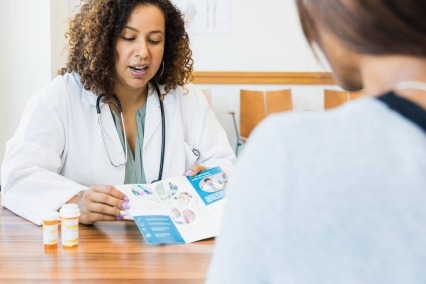Researchers from the Substance Abuse and Mental Health Services Administration (SAMHSA), the National Institutes of Health’s (NIH) National Institute on Drug Abuse (NIDA), Centers for Medicare & Medicaid Services (CMS), and the Centers for Disease Control and Prevention (CDC) found that among a cohort of 137,000 Medicare beneficiaries who experienced a nonfatal overdose in 2020, almost 24,000 (17.4%) experienced a subsequent nonfatal overdose, and about 1,300 (1%) died from overdose in the following year. Results were published today in JAMA Internal Medicine, identifying both effective interventions and significant gaps in care.
“People who have experienced one overdose are more likely to experience another,” said Miriam E. Delphin-Rittmon, Ph.D., HHS Assistant Secretary for Mental Health and Substance Use and the leader of SAMHSA. “But we found that when survivors received gold-standard care such as medications for opioid use disorder and naloxone, the chances of dying from an overdose in the following year drop dramatically. In short, medications for opioid use disorder, opioid overdose reversal medications, and behavioral health supports save lives.”
The study identifies effective, lifesaving interventions following initial nonfatal overdoses. The odds of dying from a subsequent lethal overdose decreased among cohort members who received methadone (58% lower odds), buprenorphine (52% lower odds), or behavioral health assessment or crisis services (75% lower odds). The risk of overdose mortality among those who filled a prescription for naloxone was also reduced by 30%.
However, significant gaps in care were also noted. Only 4.1% of the cohort received medications for opioid use disorder (MOUD), and only 6.2% filled a prescription for naloxone, commonly known as Narcan, despite these being gold-standard interventions. Beneficiaries receiving MOUD waited a mean of 72 days between their nonfatal overdose and receiving medication.
Overall, 89% of beneficiaries in the cohort received behavioral health services in the 12 months following their nonfatal overdose for a median duration of 15 days throughout the year.
“These findings underscore the importance of high-quality care following an overdose, and the opportunities that remain to connect people with needed care. Only 4% of beneficiaries received these medications after experiencing a nonfatal overdose and—for those who did receive the medications—there was a significant delay ranging from 6 to 105 days,” said Dr. Dora Hughes, Acting Chief Medical Officer and Acting Director of the Center for Clinical Standards and Quality for CMS. “Increasing the number of beneficiaries accessing these medications in a timely manner will save lives.” These findings contribute to the growing body of research showing that while MOUD and overdose reversal medications save lives, they are rarely incorporated into care following an overdose.
These findings contribute to the growing body of research showing that while MOUD and overdose reversal medications save lives, they are rarely incorporated into care following an overdose.
“At a time when over 100,000 people continue to die each year from overdose, we must prioritize making effective treatments and tools accessible – especially to those who are at the highest risk,” said Nora D. Volkow, M.D., Director of the National Institute on Drug Abuse. “Connecting with someone in an emergency department or after they have experienced a nonfatal overdose provides a valuable opportunity to both support them acutely in that moment, as well as offer lifesaving tools that can protect them from future overdoses, link them into treatment, and foster recovery.”
President Biden’s Unity Agenda for the Nation prioritizes delivering lifesaving medication and care across America in order to beat the opioid epidemic.
- The US Department of Health and Human Services Overdose Prevention Strategy supports evidence-based treatments, including access to methadone and buprenorphine, and harm reduction strategies such as saturation of opioid overdose reversal medications.
- Since the end of the analyzed cohort, significant policy and programmatic changes have been made across the federal government to save lives and support communities:
- The Consolidated Appropriations Act of 2023 removed federal requirements for providers to have specialized waivers to prescribe buprenorphine for opioid use disorder. Now, any provider with Schedule III prescribing authority may prescribe buprenorphine products.
- The Food and Drug Administration (FDA) has approved multiple naloxone medications as over-the-counter, removing the need for a prescription.
- In 2024, SAMHSA made the first rule updates to 42 CFR Part 8 – the federal regulation that governs opioid treatment programs (OTP) – in more than two decades. This change made many COVID-era flexibilities for MOUD permanent, increasing access to medications in rural areas and for people with transportation challenges. OTP admission criteria also were updated to remove significant barriers to entry.
- In August 2023, CDC awarded new five-year cooperative agreements to 90 state and local health departments under two distinct Overdose Data to Action (OD2A) programs. The cooperative agreements fund health departments at all levels of government to expand drug overdose data and prevention efforts and build partnerships across public health, behavioral health, health systems, communities, and public safety.
- NIH is supporting research on implementation of evidence-based practices in healthcare, community, and justice settings, as well as novel treatment strategies for addiction, including strategies aimed at new treatment tools and strategies to improving engagement and retention in care.
- CMS is executing a Behavioral Health Strategy to deliver increased coverage and access to behavioral health care, including strengthened access through schools for Medicaid and CHIP eligible kids, grants and guidance to support community-based mobile crisis intervention services, increased telehealth services through Medicare for behavioral health and buprenorphine initiation, and expanded access to behavioral health providers in the Marketplace. CMS also continues to test innovative care delivery and payment models such as the Innovation in Behavioral Health, Making Care Primary, Value in Opioid Use Disorders Treatment and Maternal Opioid Misuse Models.
“CDC has a strong focus on preventing health problems before they occur, including in the overdose space,” said Allison Arwady, M.D., M.P.H., director of CDC’s Injury Center. “We work closely with our state and local partners across the country to collect data and drive local prevention actions, and just as closely to coordinate our work with our other federal agency partners. This study highlights that as a society, we are still missing many opportunities to prevent fatal overdoses, and we must continue to work together at all levels to save lives.”
If you or someone you know is struggling or in crisis, help is available. Call or text 988 or chat at 988lifeline.org. To learn how to get support for mental health, or substance use conditions, visit FindSupport.gov. If you are ready to locate a treatment facility or provider, you can go directly to FindTreatment.gov or call 800-662-HELP (4357).
Find out how you can help at CDC’s Stop Overdose campaign.
Reference:
- CM Jones, et al. Overdose, Behavioral Health Services, and Medications for Opioid Use Disorder After a Nonfatal Overdose. JAMA Internal Medicine. DOI: 10.1001/jamainternmed.2024.1733 (2024).
About the National Institute on Drug Abuse (NIDA): NIDA is a component of the National Institutes of Health, U.S. Department of Health and Human Services. NIDA supports most of the world’s research on the health aspects of drug use and addiction. The Institute carries out a large variety of programs to inform policy, improve practice, and advance addiction science. For more information about NIDA and its programs, visit www.nida.nih.gov.
About the National Institutes of Health (NIH): NIH, the nation’s medical research agency, includes 27 Institutes and Centers and is a component of the U.S. Department of Health and Human Services. NIH is the primary federal agency conducting and supporting basic, clinical, and translational medical research, and is investigating the causes, treatments, and cures for both common and rare diseases. For more information about NIH and its programs, visit www.nih.gov.
About substance use disorders: Substance use disorders are chronic, treatable conditions from which people can recover. In 2022, nearly 49 million people in the United States had at least one substance use disorder. Substance use disorders are defined in part by continued use of substances despite negative consequences. They are also relapsing conditions, in which periods of abstinence (not using substances) can be followed by a return to use. Stigma can make individuals with substance use disorders less likely to seek treatment. Using preferred language can help accurately report on substance use and addiction. View NIDA’s online guide.
NIH…Turning Discovery Into Health®




